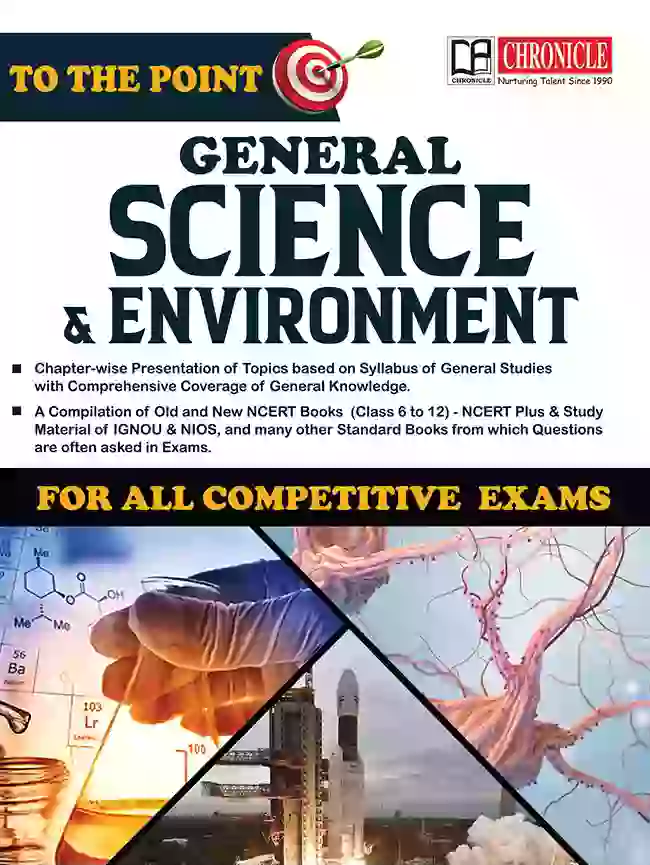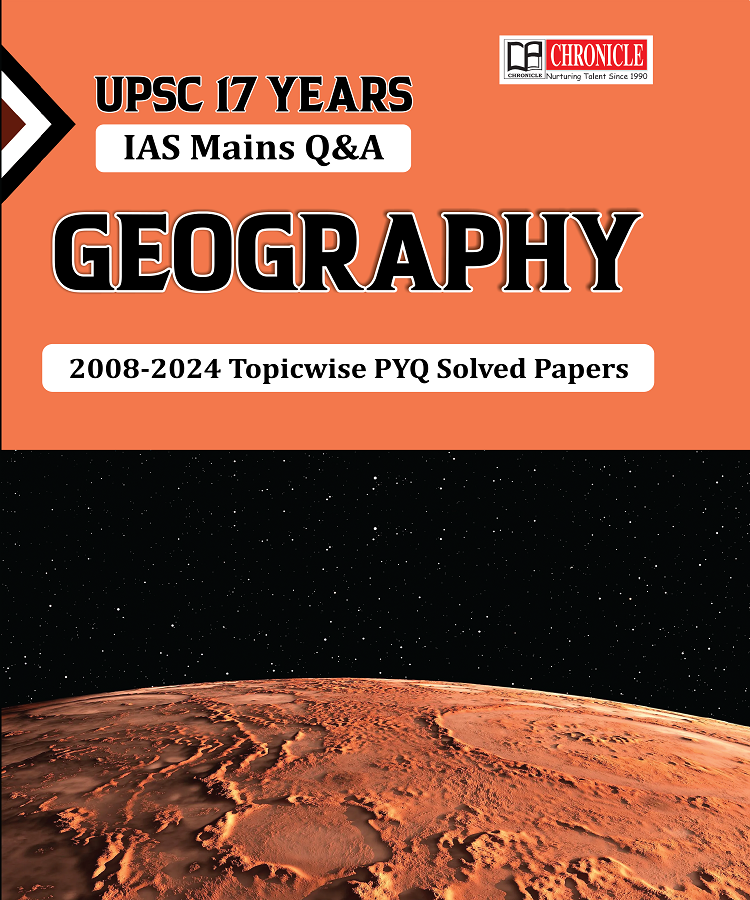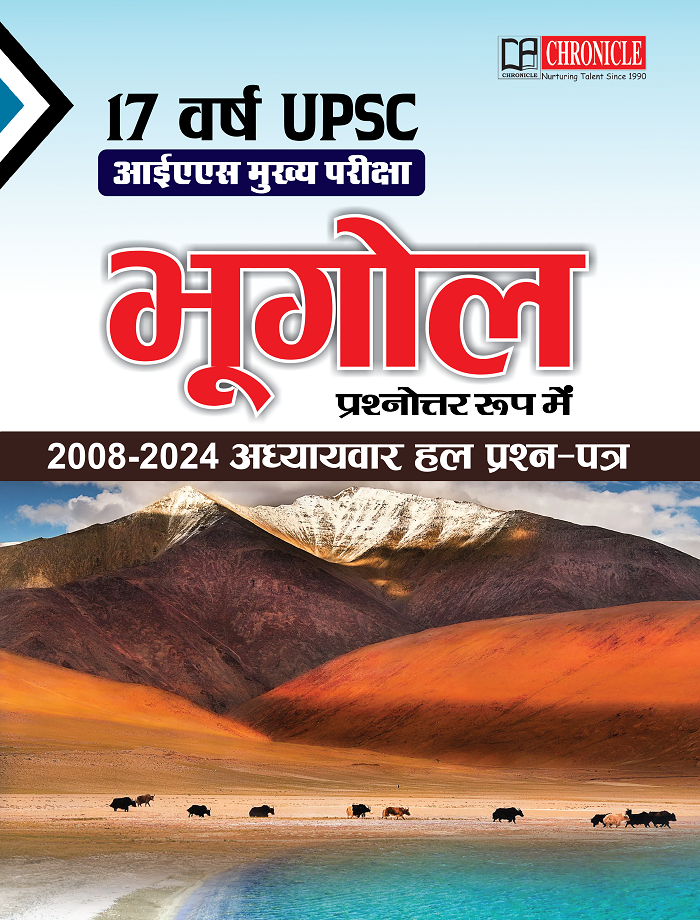Chronicle To The Point General Science & Environment
Chronicle To the point NCERT plus for General studies & General Knowledge, The compilation of NCERT Books, IGNOU, NIOS & State Board for all competitive exams
Chronicle To The Point NCERT Plus General Science & Environment for all competitive exams – comprehensive coverage with chapter-wise presentation of topics based on UPSC/State PSCs General Studies syllabus. Access a unique compilation from old and new NCERT books, IGNOU & NIOS study materials and standard books from which questions are frequently asked in exams. Explore UNIT I: PHYSICS; UNIT II: CHEMISTRY; UNIT III: BIOLOGY; UNIT IV: ECOLOGY and ENVIRONMENT in NCERT Plus for in-depth preparation of UPSC and other competitive examinations.
About the book & Content
TO THE POINT NCERT Plus :
For All Competitive Exams –
- Chapter-wise Presentation of Topics based on Syllabus of General Studies with Comprehensive Coverage of General Knowledge.
- A Compilation of Old and New NCERT Books (Class 6 to 12) - NCERT Plus & Study Material of IGNOU & NIOS, and many other Standard Books from which Questions are often asked in Exams.
Content
UNIT I: PHYSICS
Units & Measurement
- Physical Quantities
- Units
- Measurement
- Dimensions of Physical Quantities
Motion
- Motion and Dimension
- Scalars and Vectors
- Distance and Displacement
- Speed, Velocity and Acceleration
- Kinematics
- Laws of Motion
- Friction
- Equilibrium
- Circular Motion
Work, Energy and Power
- Work
- Energy
- Renewable Energy
- Conventional Sources of Energy
- Power
- Collisions
Gravitation
- History of Gravitational Theory
- Weight
Mechanical Properties of Solids and Fluids
- Mechanics of Solids
- Elasticity
- Stress
- Strain
- Three Moduli of Elasticity
- Bonding in Solids
- Mechanics of Fluid
- Pressure
- Fluid Dynamics
Thermodynamics
- Thermodynamics
- Internal Energy
- Newton’s Law of Cooling
- Scales of Temperature
- Kinetic Theory of Gases
- Thermal Expansion
- Mechanism of Heat Transfer
Oscillation
- Simple Harmonic Motion
- Uniform Circular Motion
Wave
- Mechanical Waves
- Electromagnetic Waves
- Matter Waves
- Waves: Miscellaneous
Sound
- Echo & Reverberation
Light
- Nature of Light
- Properties of Light
- Types of Mirrors
- Lens
- Human Eye
- Theories of Light
- Photometry
- Colour
Magnetism
- Magnet
- Magnetism
Electricity
- Electric Charge
- Electric Current
- Ohm’s Law
- Coulomb’s Law
- Electrostatic Nature of Substances
- Magnetic Effects of Electric Current
Atomic Physics
- Atom and Nucleus
- X-Rays
- Structure of the Atoms and Nucleus
- Mass-Energy
- Nuclear Reactions
- Radioactivity
- Semiconductor
- Communication
UNIT II: CHEMISTRY
Nature and Scope of Chemistry
- Scope of Chemistry
- Main Branches of Chemistry
- Nature and Scope of Chemistry
- Work of Chemists in Different Fields
- Use of Chemistry in Different Sectors
- Problems Caused by Progress in Chemistry
Atoms
- Structure of an Atom
- Dalton’s Atomic Theory
- Discovery of Electrons (Cathode Rays
- Rutherford’s Atomic Model (Proton
- Discovery of Neutron
- Modern Atomic Theory
- Atomic Molecular Theory
Matter
- Characteristics of Particles of Matter
- States of Matter
- Physical and Chemical Properties of Matter
- Conversion of States
- Forces of Interaction
- Homogeneous and Heterogeneous Mixtures
- Ideal Gas Law
- Measurement of Matter
- Law of Chemical Formation
Periodic Properties of Elements
- Mendeleev's Periodic Table
- Modern Periodic Law
- Horizontal and Vertical Relationships in the Periodic Table
- Electronic Configurations
- Filling of Atomic Orbitals
- Quantum Numbers
Chemical Bonding
- Octet Rule
- Theories on Chemical Bonding
- Types of Chemical Bonds
Radioactivity
- Discovery of Radioactivity
- Emission of α, β and γ Radiations
- Theory of Radioactive Disintegration
- Nuclear Reactions
Chemical Reaction
- Type of Chemical Reaction
- Chemical Kinetics
- Chemical Reactions
- Oxidation & Reduction
- The Colloidal State
Catalysis
- Catalyst
- Acids, Bases & Salts
Metals, Metallurgy and Non-Metal
- Metals
- Non-Metals
- Uses of Metals
- Uses of Non-Metals
Electrochemistry
- Conductors
- Cell
Soil Chemistry
- Soil
- Soil Chemistry
- Composition of Soil
- Fertilizers and Pesticides
- Biochemistry
Food Chemistry
- Components of Food
- Food Chemistry
- Food Preservatives
- Emulsifiers and Stabilizers
- Food Sweeteners
- Food Flavours
- Food Colours
Environmental Chemistry
- Components of Environment
- Pollution
- Air Pollution
- Water Pollution
Scientific Laws, Instruments & Inventions
- Scientific Laws
- Scientific Instruments
- Inventions & Inventors
- Glossary
UNIT III: BIOLOGY
Introduction to Biology
- The Living World
- Sub-Branches of Biology
- Famous Biologists and their Contributions
Cell Biology
- Cell Theory
- Cell Structure
- Cell Organelles and Their Functions
- Cell Types
- Cell-Division and Cell-Cycle
- Biomolecules
- Carbohydrates
- Proteins
- Lipids
- Nucleic Acids
- Enzymes
- Hormones
- Primary Metabolites and Secondary
- Metabolites
Genetics
- Mendel’s Experiments and Heredity
- Mendel’s Laws of Inheritance
- Crossing Over or Recombination
- Mutation
- Genetic Disorders due to Chromosomal
- Abnormalities
- Genetic Terminologies
Evolution
- Theories of Origin of Life
- Evolution of Life Forms
- Mechanism of Evolution
- Origin and Evolution of Man
Diversity in the Living World
- Taxonomy
- Biological Classification
- Viruses
Plant Kingdom
- Classification of Plants
- Cryptogamae
- Phanerogamae
Morphology of Flowering Plants
- The Root
- The Stem
- The Leaf
- The Flower
- The Fruit
- The Seed
Anatomy of Flowering Plants
- The Tissue System
- Anatomy of Dicotyledonous and Monocotyledonous Plants
Plant Physiology
- Mode of Nutrition in Plants
- Transport in Plants
- Nutrition in Plants
- Photosynthesis in Plants
- Respiration
Reproduction in Plants
- Asexual Reproduction
- Sexual Reproduction
Animal Kingdom
- Basis of Classification
- Classification of Animal Kingdom
- Phylum Protozoa
- Phylum Porifera
- Phylum Coelenterata (Cnidaria)
- Phylum Ctenophora
- Phylum Platyhelminthes
- Phylum Aschelminthes or Nematoda
- Phylum Annelida
- Phylum Arthropoda
- Phylum Mollusca
- Phylum Echinodermata
- Another System of Classification
- Phylum Hemichordata
- Phylum Chordata
Skeletal System
- Skeletal System
- Division of the Skeletal System
- Muscular System
Animal Tissue
- Type of Animal Tissues
- Blood
- Lymph
- Blood Groups
Digestive System
- Parts of Alimentary Canal
- The Accessory Structures
- Functioning of Digestive System
Sensory Organs
- Eyes
- Ears
- Nose
- Tongue
- Skin
Nervous System
- Basic Cells of the Nervous System
- Divisions of Neural System
Endocrine System
- Hormones
- Endocrine Glands
- Exocrine Glands
Immune System
- Tissues and Organs Involved in the Immune System
- Types of Immunity
- Vaccination
Circulatory System
- Heart
- The Blood Vessels
- Blood Circulation
Respiratory System
- Parts of Respiratory System
- Transport of Oxygen and Carbon Dioxide
- Major Respiratory Disorders
Excretory System
- Excretory Products and their Elimination
- Human Excretory System: Anatomy
- Functioning of Excretory System
- Urine Formation
Reproductive System
- Asexual Reproduction
- Sexual Reproduction
- Reproduction in Human Beings
- Fertilization
Health and Nutrition
- Nutrition
- Health and Disease
Disease and Diagnosis
- Types of Diseases
- Communicable Diseases
- Non-Communicable Diseases
Biotechnology
- Branches of Biotechnology
- Principles of Biotechnology
- Applications of Biotechnology
- Biotechnology in India
- Biotechnology Terminologies
Microbiology
- Historical Roots of Microbiology
- General Characteristics of Microorganisms
- Classification of Microorganisms
- Bacteria (Monera)
- Protozoa
- Fungi
- Algae
- Virus
- Microbial Metabolism
- Enzymes
- Cellular Respiration
- Fermentation
- Terminologies Related to Microbiology
UNIT IV: ECOLOGY AND ENVIRONMENT
Introduction to Environment
- Components of Environment
- Segments of Environment
- Importance of Environmental Studies
- Challenges Facing Environment
Ecology and Ecosystem
- Ecology
- Principles of Ecology
- Ecological Succession
- Biotic Interactions in a Food Web
- Pollutants and Trophic Levels: Bio-magnification and Bioaccumulation
- Bio-Geo Chemical Cycles or Nutrient Cycling
- Natural Ecosystems
- Functions of Ecosystem
Biodiversity and Conservation
- Biodiversity
- Importance of Biological Diversity
- Loss of Biodiversity
- Conservation of Biodiversity
Environment and Natural Resources
- Natural Resources
- Non-Renewable Resources
- Renewable Energy Resources
- Energy Efficiency
Global Warming
- Global Warming
- Ozone Depletion
Environmental Pollution and Land
- Degradation
- Pollution
- Land Degradation
- Soil Erosion
- Wasteland Management
Forestry and Environment
- Forests
- Social Forestry
- Deforestation
Environmental Crisis and Hazards
- Major Environmental Hazards
- Sendai Framework for Disaster Risk
- Reduction
Environmental Legislation
- National Legislation
- International Legislations
315
Specifications |
|
|---|---|
| Availability | In-Stock |
| Language | English |
| Product Type | Print Edition |
| Edition | 2024 |
| Book Code | 439 |
| Shipment | Free |
| No. of Pages | 472 |
Ratings & Reviews










